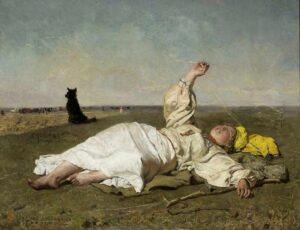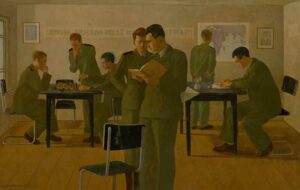Aleksander Hudzik
What do you know about socialist realism? Perhaps that it was a weird aberration in art during the Cold War era, when nebbish Soviet artists were trying to depict life in a heavy handed manner like the sculptures of Kim Jong-il that adorn every square in Pyongyang. There were paintings of workers and tractors and factories and fields, it was an exasperating outpouring of ideology that permeated all aspects of life.
If you have a better grasp of art and culture behind the iron curtain you might know that socialist realism was an official tool of the state. Officially institutionalized in Poland in 1949, an entire division of artists eagerly or perhaps more opportunistically supported what Aldous Huxley called the Brave New World. It lasted less than a decade. When Josef Stalin died in 1953, socialist realism went with him.
But was it really only a moribund period where the art was no more free than the dissidents imprisoned in Gulags? Is there anything we can learn today from the socialist realists? This seems to be the central question of the new exhibition Cold Revolution at the Zachęta National Gallery of Art in Warsaw.

Google Art Project
Socialist realism was not the first moment where art turned its eyes to the working class. Galleries of 19th-century paintings are filled with the half naked bodies of workers, like those in Gustave Caillebotte’s The Floor Scrapers, or the women taking a break after a long day of labour in Josef Chełmoński’s Indian Summer. In 1924 the Nobel Prize was given to Polish writer Władysław Reymont for his work The Peasants, which is known as the first modern story written from the perspective of the peasantry. What was anticipated in pre-war European art came into full bloom during the times of socialist realism. The exhibition Cold Revolution, curated by Joanna Kodjak and Jérôme Bazin, follows the nuanced paths that socialist realism opened.
The history of socialist realism belongs to the realm of the art world, but we can also see it through a broader lens, suggested in the new book written by Polish scholar Adam Leszczyński, Ludowa Historia Polski (A People’s History of Poland). This title might be familiar for American readers: Leszczynski uses the same frame as Howard Zinn in his famous A People’s History of the United States, written not from the perspective of the minority: those who owned the land and factories, but from those who served these landscapes and industries, who lived their lives within them. Those whose history has not previously been written.
The exhibition opens with a beautiful, large-scale painting of workers by Hungarian artist Hans Mattis-Teutsch. Proletarians are marching towards the better future. The atmosphere is as bright as their freshly cleaned and rolled shirt cuffs, there is no pain, no sweat, not a single stain, because such things are not part of socialist realism. And from there we set sail through seven large rooms filled with paintings, movies, sculptures, and toys, which all show us how capacious socialist realism actually was.
Another large painting depicts a couple looking into the distance, where we are reminded of the one thing we tend to forget. Those people are war survivors, what they see might be a better future, but it is within the context of a traumatic past filled with homes and families buried during WW2. This interpretation of socialist realism can be a challenge for those who think that postwar trauma can only be represented through abstraction, because there is no art after Auschwitz.
We speculate about what those people were thinking, how they were processing and coping with their traumas. The exhibition doesn’t give us complimentary texts that might build the context for what we see. If we want to understand the movement better, we are to do it through the collection of essays written for the exhibition catalogue, which is one of the greatest books about socialist realism that I have ever held in my hands.
Context is crucial, and here, the context for propaganda in painting is built around toys, posters, and movies. Mundane life. It was a peculiar kind of epiphany for me, when I saw a Czechoslovakian poster of a farmer drinking fresh mineral water. It could have been an American advertisement from the 1950s if we just replaced the water with an ice cold bottle of Coca-Cola. The epiphany is simple: it’s perhaps the first time I saw the people, not the ideology, in socialist realism. I felt their happiness and sorrow, hidden behind what is told in the language of propaganda. This was the reality of their lives.

Courtesy of Slovak National Gallery, Bratislava
Here in Poland, we denied our own past. We told proletarians ‘it wasn’t your country you built, it was Communism, it wasn’t your history you created, it was the Soviet State. It wasn’t your responsibility for the wars you took part in, it wasn’t you, it was your oppressor’. In 1989, we decided to remove these efforts and life achievements out of sight, quite literally. The vast majority of our socialist realist sculptures are kept in a rundown countryside museum in Kozłówka. The same thing happened to Hungarian socialist realism: their sculptures are now kept in a Budapest park of unwanted history.
“A thorough, bias-free reassessment of the art made in the former Eastern Europe under Stalinism feels all the more important today, as battles over the collective memory of the Communist period are waged in these countries,” writes Magdalena Moskalewicz on the second life of socialist realism for Art in America in 2021, as Poland and Hungary grapple with our shift to the far-right. The state has created a new kind of propaganda where everything that was before 1989 no longer belongs to our history. The most successful note of this exhibition is the confounding of this demagoguery with reality. We are told we don’t own our history. It is narrated and depicted by the rich, by the state. But of course that’s not true, we do own it, and it is illustrated in these paintings and embedded in the sculptures, left to us to learn how to respect and continue to tell, to keep from being buried.
Volume 35 no. 6 July/August 2021

